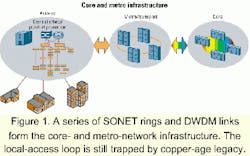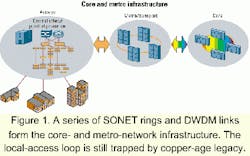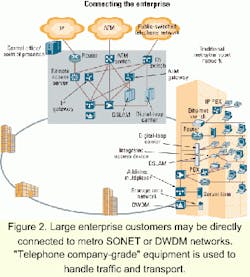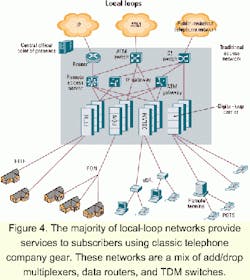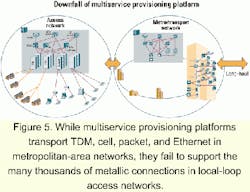Heralding the real fiber age
Transforming today's PSTN for the fiber age will require the right mix of the right elements at the right time.
TOM CORKER, Calix Networks Inc.
Amid all the hoopla surrounding today's "exploding bandwidth" phenomenon, one fact looms prominently: The vast majority of business and residential subscribers in North America are still relegated to "slowband" voice- and data-communications carried over brittle, copper-age public-switched telephone network (PSTN) infrastructure. The magic of vastly available and cost-effective bandwidth is still ostensibly well beyond our reach.
Over the past several years, interim technologies, including DSL, cable modem, and wireless point-to-point services, have emerged to fill the connectivity chasm. Yet, "not available in all service areas" still annotates promotional fine print as these services are introduced. The majority of bandwidth is still trapped within the core fiber networks but is slowly migrating into MANs. Still, subscribers wait-and wait. While greater bandwidth may be inching closer to mainstream businesses and residences, it's happening at a glacial rate.
Sufficient subscriber demand-coupled with equal parts equipment availability and a reasonable expectation of carrier profit-will ultimately spur fiber's final expansion into business and residential accounts. During this stage of connectivity transformation, conventional local-loop access and transport technologies will still be needed to support the metallic, circuit-switched, plain-old-telephone-service infrastructure. Yet, as more fiber is pulled and networks are lit, the telephone company infrastructure will need to transform. It must become capable of elegantly evolving to a data-centric, packet-based, access/transport future, enabled by fiber. It must also accomplish that at the individual subscriber level.
The bulk of high-bandwidth communications traffic today courses over a series of SONET rings or DWDM links that form the core and MAN infrastructure. Core-network backbones typically feature optical line rates between OC-48 (2.5 Gbits/sec) and OC-192 (10 Gbits/sec). A majority of optical MANs are similarly built and operate between OC-3 (155-Mbit/sec) and OC-48 rates. The local-access loop is still trapped by its copper-age legacy.Larger enterprise customers with higher-capacity requirements can connect directly to the metropolitan-area SONET or DWDM network. "Telephone company-grade" gear must be used to process and manage all the varying traffic types and transport protocols. Typically, private branch exchanges (PBXs) or Class 5 telephone switches handle and process time-division multiplexed (TDM) traffic such as voice. Routers, data switches, and ATM gear are used to process data. Add/drop multiplexers (ADMs) convert the traffic streams from electrical to optical signals prior to ingressing the metro network. In more sophisticated enterprise networks, ATM equipment may be used to consolidate voice, data, and video traffic before optical transport (see Figure 2).
Other enterprises may rely on Internet protocol (IP) in their data networks. To extend its usefulness, these sophisticated network architects may be experimenting with voice-over-IP (VoIP), which removes the need for TDM-based equipment entirely. But VoIP is still an emerging technology and not widely deployed due to unresolved issues surrounding quality-of-service (QoS) mechanisms for voice traffic. In the minds of some, the TDM/PSTN telecommunications world is vastly different from the data world where IP, frame relay, and Ethernet networks dominate. Many in the data world foresee a future where IP over SONET, DWDM, or glass (fiber) will become the protocol of choice. Others believe Ethernet will rule.Due to its ubiquity, Ethernet merits special attention. Because it has become the de facto enterprise networking technology, efforts are focusing on developing standards that offer this pervasive networking technology seamlessly between enterprise and wide-area networks. While Ethernet may one day emerge as an alternative to SONET and DWDM, the technology will not supplant the massive capital outlays already expended on these incumbent technologies any time soon. In reality, Ethernet traffic can be readily transported over both SONET and DWDM networks, but not vice versa. Meanwhile, there are other interoperability issues that must be faced. However, the expansion of enterprise Ethernet is most likely.
Even though the PSTN and optical networks have co-existed for more than a decade, one nagging problem persists. The PSTN signaling hierarchy is not well matched with its optical counterpart for handling "bandwidth-bursty" data traffic. As a result, substantial inefficiencies may arise when unpredictable amounts of data traffic cross back and forth between the electrical and optical signaling domains (see Figure 3).
Being able to efficiently fill OC-n and DWDM channels with an unpredictable mix of DS-n voice and data traffic is something at which to marvel. The transport efficiency dilemma is exacerbated as more business subscribers seek better and faster connection options. Servicing these requests takes a certain understanding of sorcery-and reliance-on a variety of sophisticated and expensive ADMs, TDM switches, routers, and customer-premises equipment. Slicing, dicing, and stuffing SONET and DWDM channels with disparate TDM, cell, and packet traffic in an efficient, cost-effective manner is truly an arcane science. Compounding the problem is the antiquated PSTN infrastructure, since optical fiber has yet to reach the subscriber majority.
The small-office/home-office (SOHO) and residential communications market in the United States is huge. Yet, only a very small percentage of these "passed over mile" customers have ever seen a strand of fiber. The majority of local-loop networks, maintained by the incumbent local-exchange carrier or shared with a competitive local-exchange carrier, provide service to these subscribers using classic telephone company gear. These networks, like those of large enterprises, are a mix of ADMs, routers, and Class 5 switches located in the COs or in controlled-environment vaults (CEVs). Digital-loop carrier (DLC) boxes in the CO/CEV are then used to provide DS-0 (64-kbit/sec) analog twisted-pair copper connections that fan out to individual small business and residential drops (see Figure 4).Realizing the limitations that DS-0 level connections pose for an increasingly computer- and data-dependent subscriber base, equipment providers have moved quickly to roll out DSL. This capability is enabled using a DSL modem at the subscriber location and DSL access multiplexer (DSLAM) network gear in the CO, CEV, or PoP, designed to support both voice and data digitally over twisted-pair copper.
Despite the exuberance of telephone company and ISP "marketers" extolling its fast-connection properties, DSL is a rather twitchy technology, much like its less successful sibling: the ISDN connection. For DSL to perform optimally, a pristine twisted-pair circuit-free of load coils, bridge taps, corrosion, and other maladies-must be available within n thousand linear feet of the DSLAM. Available circuits in this condition are the exception, rather than the norm, in today's PSTN local-loop network. Furthermore, due to deregulation, cable and satellite providers are competing with the telephone companies to provide SOHO and residential subscribers with enriched bandwidth services. Cable modems and satellites now offer bandwidth comparable to that available over DSL.
However, each of these approaches carries a set of limitations. It's still an inefficient mix of analog, digital, optical, and wireless equipment. Old equipment, substandard cabling, oversubscription, and lack of manpower and money to improve the basic infrastructure all impinge on the bandwidth promise. While higher-bandwidth DSL, cable-modem, and wireless technologies continue spreading into the SOHO and residential markets, equipment interoperability and manual service provisioning issues persist, perpetuating the lack-of-bandwidth legacy.
Bringing fiber to the subscriber will not be easy. Yet, this fiber/bandwidth vision will ultimately converge with today's technological, business, and market reality. Essential to this convergence will be extracting the remaining value from PSTN equipment, while providing a beachhead for advanced future services. Any new elements-whether copper-enhancing or fiber-enabling-introduced into this infrastructure, must provide a high degree of standards-based interoperability, elastic provisioning, and super-scalability to support existing network local-loop, access, and transport applications well into the future.
Initial network transformation began in the core long-haul networks where maximum technological and financial impact was easily realized through next-generation equipment adoption. Today, these extremely high-speed SONET rings and DWDM links form the backbone of national and transoceanic optical networks. Many advancements in photonics and silicon-first applied in these network core systems-are now showing up in multiservice provisioning platforms (MSPPs) targeted for metropolitan-area SONET and DWDM transport networks. These bandwidth-efficient, scalable telephone company systems are designed to interface directly with metro SONET rings and DWDM links. They offer better transport efficiency, along with traffic grooming, through dynamic bandwidth allocation and statistical multiplexing.But while MSPPs are intended to replace the numerous current-generation ADMs, routers, and switches used to aggregate TDM, cell, packet, and Ethernet services for transport over the greater metro network, these systems are fundamentally optical transport platforms. They were never intended for use in large-scale, subscriber-loop environments that must support thousands of metallic access connections as well as fiber (see Figure 5).
Mercifully, merging existing access and transport requirements within the subscriber loop with the new fiber era will not require sorcery. A new class of highly integrated, multiservice optical access platform (OAP) is evolving that combines network access and transport features with high-density metallic and fiber connectivity in the same chassis. These systems offer capabilities extending far beyond those of mere MSPPs.
OAPs feature a line card and chassis architecture that can include the DLC and DSLAM functions needed in most local-loop PSTN networks. They also provide optical add/drop multiplexing for on-board SONET, DWDM, and Gigabit Ethernet services with optical interfaces to fiber networks. Embedded edge switching, routing, and digital-crossconnect functions work together to process, groom, and manage any combination of TDM, cell, and packet traffic, including ATM, frame relay, and (IP/MPLS), as shown in Figure 6.
The global perception of how access and transport network elements should interoperate is rapidly changing. This perception can now match reality, since OAPs are built to provide any prevailing services, in any combination, over any physical network. They contain the right mix of essential elements needed to transform the PSTN infrastructure into something that brings higher bandwidth and rich new services to the subscriber.
At the same time, OAPs preserve a carrier's infrastructure investment by extending the life of high-density metallic connections. They also allow fiber to be seamlessly integrated into the network when the time is right, irrespective of whether fiber is needed at the subscriber's point of demarcation, in the local loop, or at the edge of the network core.By design, OAPs deliver substantial provisioning flexibility, bandwidth granularity, traffic grooming, and signal aggregation capabilities. Because subscriber services are a mix of analog and digital signals-and traffic is dynamic by nature-real-time service provisioning with assignable QoS and class-of-service (CoS) levels are inherent system features. An OAP can assign QoS and CoS on any system port, on any traffic type, at any rate, or "on the fly."
This never-before-seen type of system will allow carriers and ISPs to develop differentiated offerings formulated to meet customer needs at the individual subscriber level. Further, because of the OAP's performance characteristics, subscribers can be assured of consistent service quality (and carriers of significant cost savings through much simplified provisioning). At the same time, telephone company and ISP service providers will be able to acquire highly accurate and quantifiable billing data.
Transforming today's PSTN for the fiber age will require a combination of the right mix of the right elements at the right time. Highly integrated and modular OAPs combine the best of access and transport technologies, along with never-before-seen levels of metallic and fiber connectivity, finally heralding the first true fiber age.
Tom Corker is vice president of optical products at Calix Networks Inc. (Petaluma, CA). He can be reached via the company's Website, www.calix.com.
